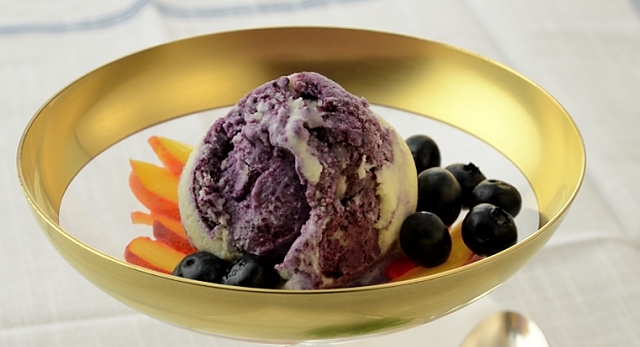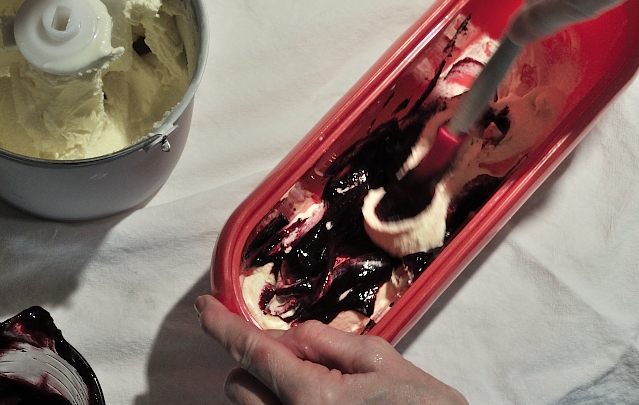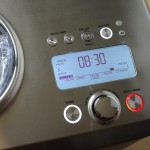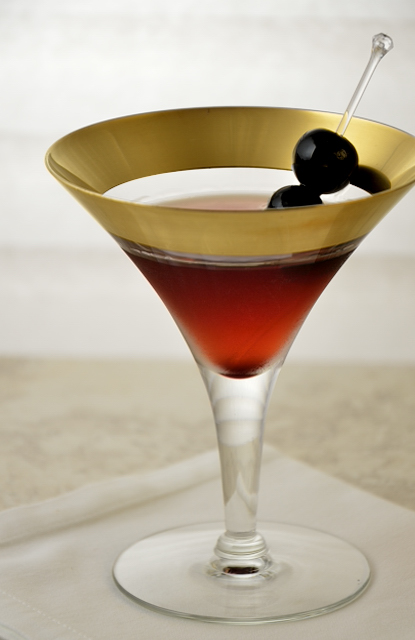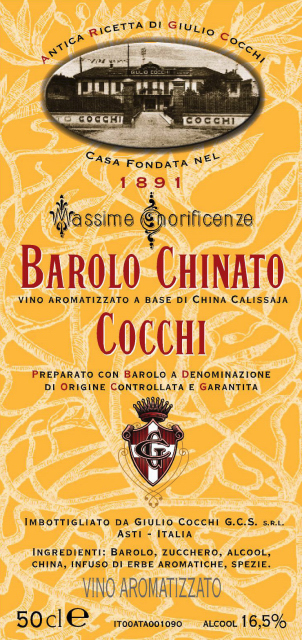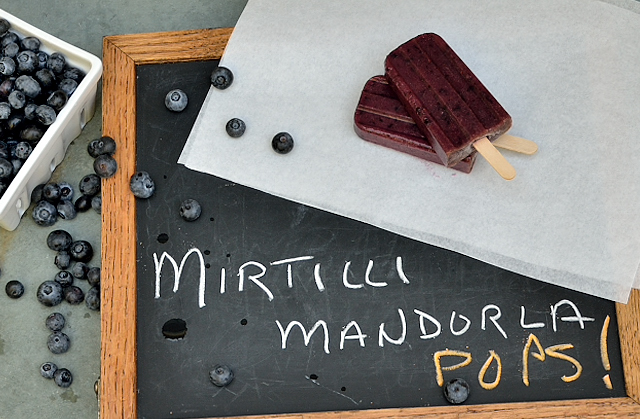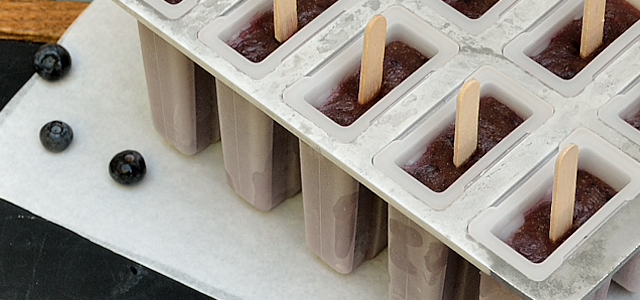Topic Index
The font size for a topic word is sized by the number of articles that reference that topic. The more articles the bigger the font.
Click on a word to search for posts with that topic. This page will reload with the search results.
Basil Blueberry Swirl Gelato
I have never been tempted by desserts with savory components. Somehow they always seemed wrong to me, so when I developed a craving for basil gelato I was surprised. Maybe it started with gorgeous peaches. Bart brought home a dozen of the most fragrant and perfectly ripe pieces of fruit I have seen all summer. My first thought was to slice the peaches, toss them in basil simple syrup and keep life easy. Then I remembered the blueberries in the refrigerator. Next, my eye drifted to my ice cream maker, and I was all in for this one.
The basil gelato base is lightly flavored, a lovely match for the blueberry swirl. Use more basil if you must, up to 50% more, but be careful, tasting occasionally after 15 minutes to be certain the infusion does not take on a bitter edge. I was concerned that the blueberry swirl might not have the body, taste-wise, to stand up to the basil, so I added some Mandorla grappa. The bitter almond and dark cherry taste of the grappa did the trick, brightening the blueberry flavor and bringing it into tight focus. This gelato is wonderful by itself, right out of the container, but served with fresh or poached yellow peaches or nectarines, or even berries, it is a very special summertime treat indeed.
Basil-Blueberry Swirl Gelato
Makes about 1 quart
After a few hours in the freezer, this takes on the perfect consistency, but after a longer freeze will be quite firm. If you find the gelato too firm to scoop, just leave it at room temperature for a few minutes. It will soften beautifully.
2 cups whole milk
¾ cup heavy cream
½ cup granulated sugar
4 large egg yolks
20 basil leaves, coarsely chopped
Pinch of kosher salt
1 ¼ cup blueberries
1 tablespoon granulated sugar
1 tablespoon fresh lemon juice
1-2 teaspoons Nardini Mandorla Grappa
Peaches, nectarines or fresh berries to serve alongside
basil leaves for garnish
Make the basil gelato:
In a medium saucepan combine milk, cream, granulated sugar, basil, and kosher salt. Cook over medium heat, stirring occasionally until the sugar has dissolved. Continue cooking until small bubbles form around the edges of the pan. Remove from the heat, cover pan and set aside to steep for twenty minutes. Strain the mixture, and return it to the pan, reheating briefly. Discard the basil.
While the mixture is heating, separate the eggs, placing the yolks in a medium heat-proof bowl, reserving the whites for another use. Whisk the egg yolks until slightly lightened. Slowly dribble half of the hot milk mixture into the beaten yolks, whisking all the while. Return the mixture to the saucepan and cook over medium heat. Use a silicone spatula to stir and scrape the bottom and sides of the saucepan until the mixture coats the back of the spatula, or reaches 180 degrees F. Do not boil.
Place a strainer over a medium stainless steel bowl and pour the mixture through. Set the bowl containing the gelato base over a second, larger bowl half-full of ice water to cool. Stir occasionally, being careful that no water seeps into the gelato base, until the mixture is cool. Cover and refrigerate 6 hours or overnight to chill thoroughly.
Make the Blueberry Swirl:
Place the blueberries, granulated sugar and lemon juice in a small saucepan and cook over medium-low to medium heat, crushing the berries as they soften and stirring often to prevent sticking and scorching. Cook until a silicone spatula leaves a broad trail when drawn across the bottom of the pan and mixture forms a thick sauce, about 12 to 15 minutes. Place a fine mesh strainer over a bowl. Use a spatula to press the mixture through the strainer, leaving the seeds and skins behind. Use a clean spatula to scrape the mixture that clings to the underside of the strainer into the bowl. This should yield about ¼ cup of puree. Discard seeds and skins. Add grappa to the puree, and stir to combine. Refrigerate until cold.
Make the gelato:
Pour the chilled base mixture into an ice cream/gelato maker and process according to the manufacturer’s directions.
Add the swirl:
When gelato has finished churning, Remove the cannister from the machine and transfer one half of the gelato to a chilled storage container, smoothing the top slightly. Pour one half of the blueberry mixture atop gelato and swirl or fold gently using just a few strokes, lifting and swirling the blueberry mixture. Repeat with the remaining ingredients. Stir as little as possible to retain rivulets of blueberry. Smooth the surface of the gelato. Place a piece of plastic wrap directly atop the gelato, and transfer to the freezer 4 to 6 hours to harden and cure.
Food Nerd Notes: To those of you who are wondering, yes, I finally got my fancy ice cream maker. I love it. Come on over.
Further reading:
Gelato!: Italian Ice Creams, Sorbetti, and Granite
by Pamela Sheldon Johns
Paperback: 112 pages
Publisher: Ten Speed Press (May 1, 2008)
Language: English
ISBN-10: 1580089232
ISBN-13: 978-1580089234
The Perfect Scoop: Ice Creams, Sorbets, Granitas, and Sweet Accompaniments
by David Lebovitz
Paperback: 256 pages
Publisher: Ten Speed Press (May 4, 2010)
Language: English
ISBN-10: 158008219X
ISBN-13: 978-158008219
The Ciao Bella Book of Gelato and Sorbetto: Bold, Fresh Flavors to Make at Home
Publisher: Clarkson Potter (May 11, 2010)
Hardcover: 176 pages
Language: English
ISBN-10: 0307464989
ISBN-13: 978-0307464989
Sweet Cream and Sugar Cones:
90 Recipes for Making Your Own Ice Cream and Frozen Treats from Bi-Rite Creamery
Hardcover: 224 pages
Publisher: Ten Speed Press (April 17, 2012)
Language: English
ISBN-10: 1607741849
ISBN-13: 978-1607741848
Making Artisan Gelato:
45 Recipes and Techniques for Crafting Flavor-Infused Gelato and Sorbet at Home
Paperback: 176 pages
Publisher: Quarry Books (January 1, 2009)
Language: English
ISBN-10: 159253418X
ISBN-13: 978-1592534180
A Passion for Ice Cream:
95 Recipes for Fabulous Desserts
by Emily Luchetti
Hardcover: 224 pages
Publisher: Chronicle Books; First Edition (April 27, 2006)
Language: English
ISBN-10: 0811846024
ISBN-13: 978-0811846028
Note: You can click on any picture to see a slide show!
I have no affiliation with any product, manufacturer, or site mentioned in this article.
Barolo Chinato – A Nectar for Winter
Barolo with Benefits
I am tempted to tell you to stop reading now and go out and buy this and taste for yourself. But I really want to share my thoughts with you. Maybe you could take a friend or a kid or a neighbor with you in the car, and your passenger could read this to you on the way to the liquor store. That would be a good idea.
From Italy’s Piemonte region, the Foot of the Mountain, comes some of the world’s most magnificent food – truffles and spectacular mushrooms, to name but two, and the wines of The House of Cocchi. My regular readers will recall my articles about Cocchi Americano and Vermouth, two of their vini aromatizzati. But Cocchi has a third aromatized wine, Barolo Chinato (key-NOT-o.) Long favored as a treatment for lung ailments, flu, headaches and as a digestivo, the old folks know and love it. Barolo Chinato has warmed and soothed body and soul for well over a hundred years.
There is some dispute as to who invented Barolo Chinato with both Giuseppe Capellano and Giulio Cocchi claiming bragging rights. Giulio Cocchi invented his Barolo Chinato in 1891, and it soon became popular in Italy and Europe. The late 19th century had already seen much experimentation in the development of fortified wines and labels everywhere read “alcool, zucchero, china, infuso di erbe aromatiche, spezie.” The House of Cocchi is now owned by the Bava family and Barolo Chinato is still made according to Giulio Cocchi’s original secret recipe.
Barolo Chinato begins with DOCG (Denominazione di Origine Controllata e Garantita) Barolo, the king of wines. What sets this apart from any other Barolo is an infusion of chinchona (China Calissaja bark – that’s the chinato part) along with herbs and spices. After almost a year’s maceration, it emerges garnet red from its casks, ready for consumption, a true vino aromatizzato, a revelation kissed with bitters. Whether you drink it at room temperature, warmed or with a chill on it, I can guarantee you will be seduced.
Now please, wine geeks, don’t get all over me about the add-ins to the Barolo. I hear you already. This is not like the time you poured your dad’s Chateau Lafite into the punch at the Frat house. Not even close. As intoxicating as the nose is, the drinking will educe more than you would think possible. This is a complex delectation, viscous, sweet and aromatic, filled with a rich warmth and the taste of orange peel, cherries and raisins, cardamom, rhubarb and gentian along with warming spices – cloves, star anise, ginger and cinnamon. But you do not taste this all at once – bitter and sweet alternate, and flavors, either one by one or in astonishing harmony, come to the fore and retreat making the wine seem almost alive. With a mildly bitter and lingering finish, Barolo Chinato is elegance in a bottle. Read the remainder of this entry »
Mirtilli Mandorla Pops
Blueberry Grappa Pops
I was inspired to make these pops as I looked through my copy of People’s Pops by Nathalie Jordi, David Carrell and Joel Horowitz. The authors are the owners of New York City’s People’s Pops. They manufacture thousands of Pops per week, but it was not always that way.
Like so many artisanal producers, they started out small using the very same home pop maker I do. Although their equipment has been upgraded, their Pops are the same. They are still made from best quality fresh fruit, vegetables and liquor and sweetened with simple syrup just as they were on Day One. Read the remainder of this entry »
